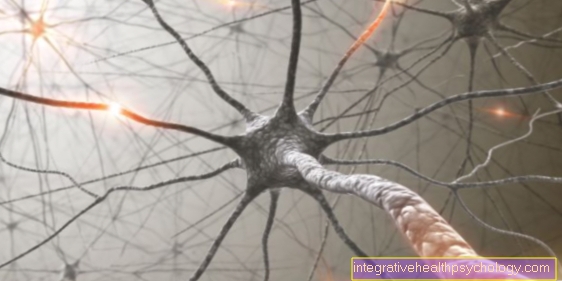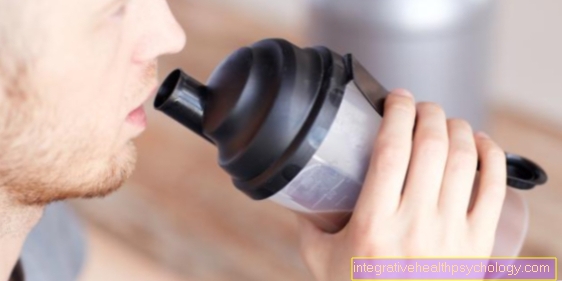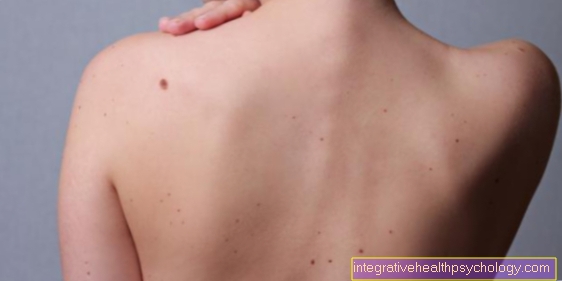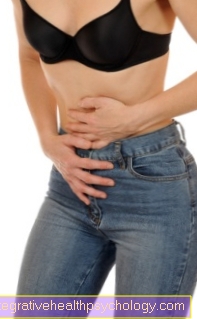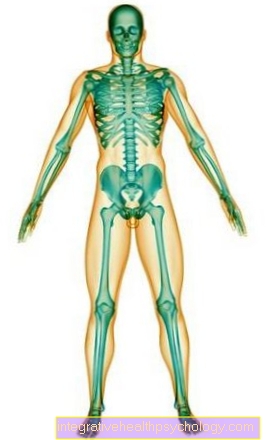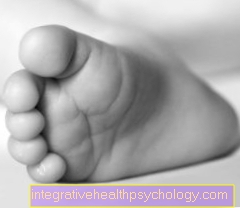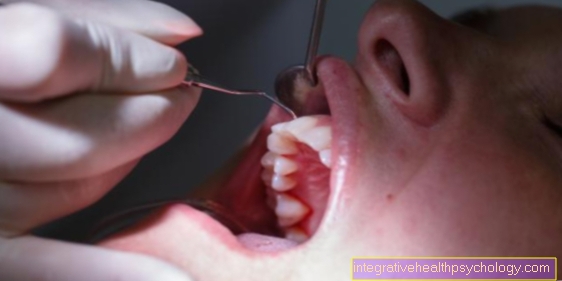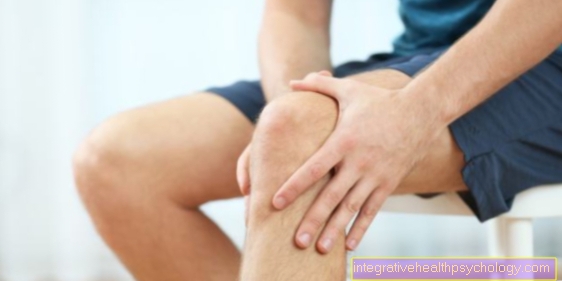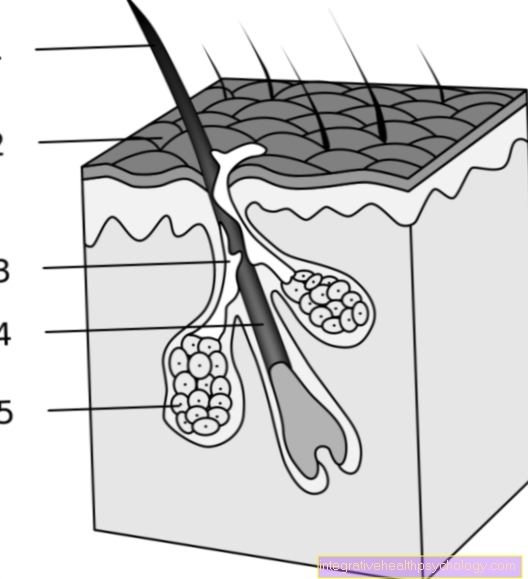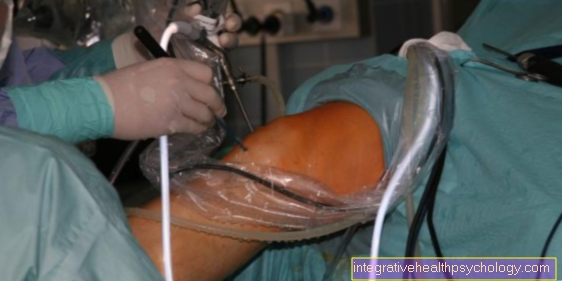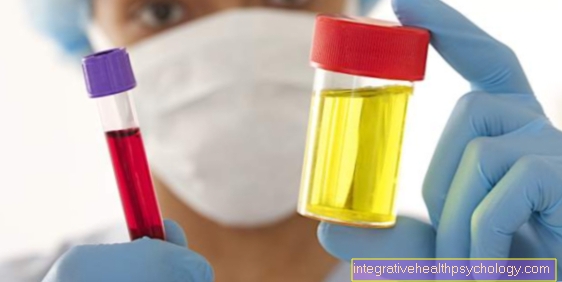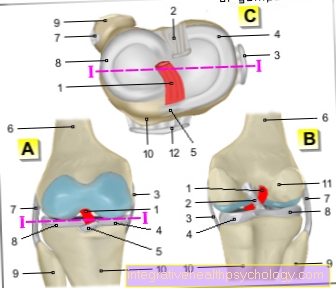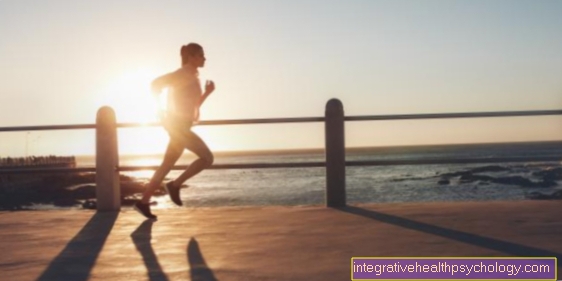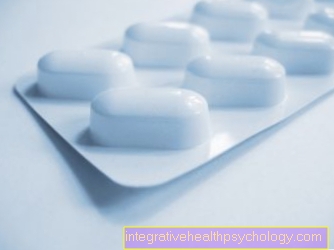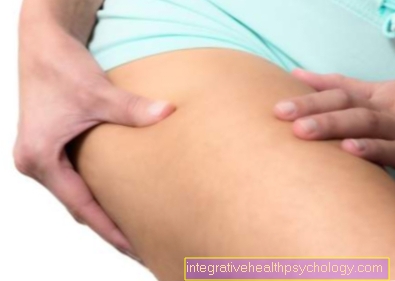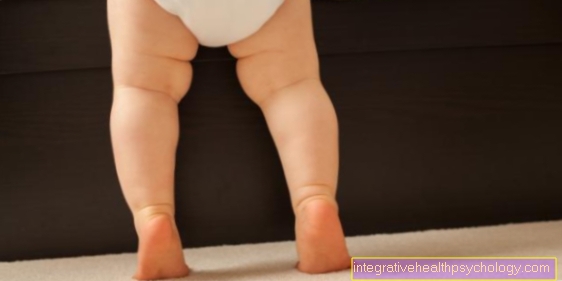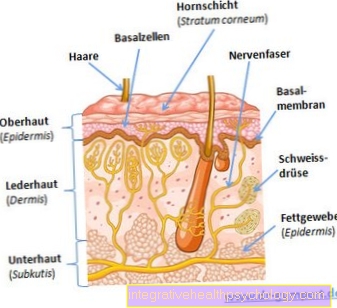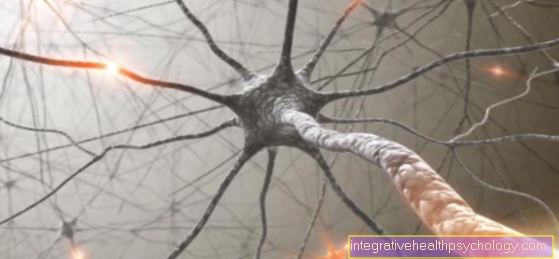Groin pain
Synonyms
Inguinal pain
definition
Under the term "Groin pain“One understands the occurrence of pain between the Abdomen, of the hip and the Thigh near the inguinal canal.
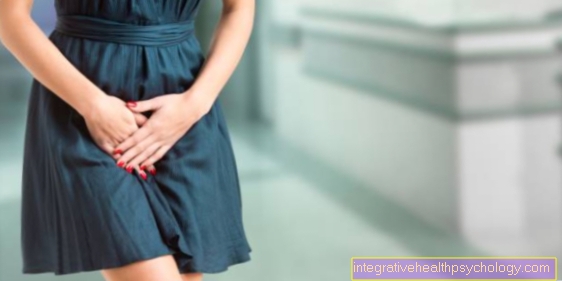
introduction
Groin pain is considered to be particularly uncomfortable and, in terms of possible causes, is particularly diverse. In humans, the groin is located in the lower, lateral area of the abdomen and forms the transition between the upper body and thigh. The strip itself is thereby through the Iliac crests limited. As an anatomical region, the human groin houses various structures. In addition to the muscles, which are divided into different boxes, there are both Inguinal ligament, Nerves and vessels, as well Lymph nodes in the groin area. For this reason, the causes of groin pain can be so different. The diagnosis of groin pain is often a major challenge for the doctor. Nevertheless, the cause of the occurrence of the groin pain must urgently be clarified and suitable treatment initiated. The possible diseases that lead to pain in the groin area usually differ in the occurrence of characteristic pain symptoms.
Depending on the cause, groin pain shows a different one localization. In addition, the fact whether the complaints acute or chronic arise, in many cases provide a decisive indication of the underlying disease. For example, a sharp, stabbing pain in the groin area that radiates down to the thigh can result in a Hip joint disease Clues. Dull pain, which is also present at rest, can in turn come through Cartilage damage caused.
The diagnosis of groin pain is particularly difficult in men. The reason for this is the fact that groin pain in men is not always caused by complaints in the area of the Testicle can be delimited. People who feel pain in the groin region for a long time and / or notice abnormalities in this area (for example Redness or swelling), you should consult a specialist as soon as possible.
Further general information on this topic can be found on our website strip.
Figure groin pain
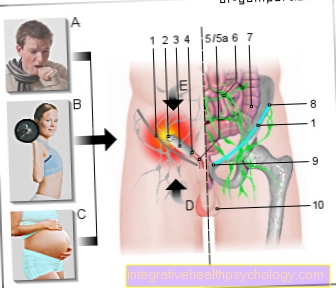
Pain in the groin
- Inguinal ligament -
Inguinal ligament - Inner inguinal ring -
Annulus inguinalis profundus - Inguinal canal -
Canalis ionguinalis - Superficial inguinal ring -
Superficial inguinal annulus - Spermatic duct (male) -
Deferens duct
5a. Round mother band (woman) -
Ligamentum teres uteri - Lymph nodes
- Colon - Intestinum crassum
- Front upper
Iliac spine -
Anterior superior iliac spine - Pubic bones -
Pubic tuberosity - Testicles / epididymis -
Testis / epididymis
Pain in the groin when:
A - cough
(Indication of an inguinal hernia)
B - lifting
(Pressure in the abdomen, athlete's groin)
C - During pregnancy
(Hormonal changes)
D - inflammation of the testicle
or the epididymis
E - Painful enlarged
Lymph nodes / diseases of the bowel
You can find an overview of all Dr-Gumpert images at: medical illustrations
Appointment with ?

I would be happy to advise you!
Who am I?
My name is dr. Nicolas Gumpert. I am a specialist in orthopedics and the founder of .
Various television programs and print media report regularly about my work. On HR television you can see me every 6 weeks live on "Hallo Hessen".
But now enough is indicated ;-)
In order to be able to treat successfully in orthopedics, a thorough examination, diagnosis and a medical history are required.
In our very economic world in particular, there is too little time to thoroughly grasp the complex diseases of orthopedics and thus initiate targeted treatment.
I don't want to join the ranks of "quick knife pullers".
The aim of any treatment is treatment without surgery.
Which therapy achieves the best results in the long term can only be determined after looking at all of the information (Examination, X-ray, ultrasound, MRI, etc.) be assessed.
You will find me:
- Lumedis - orthopedic surgeons
Kaiserstrasse 14
60311 Frankfurt am Main
You can make an appointment here.
Unfortunately, it is currently only possible to make an appointment with private health insurers. I hope for your understanding!
For more information about myself, see Lumedis - Orthopedists.
Causes of Groin Pain

Groin pain can be caused by a variety of medical conditions. The quality and intensity of the complaints perceived by the affected patient play a decisive role in limiting the possible pathogenesis of groin pain.
In general, men are about eight to nine times more likely to develop an inguinal hernia than women. The reason for this is the different anatomy of the groin region. During the development of a boy in the womb, the testicles migrate from the abdomen through the inguinal canal to the scrotum. Only then can the inguinal canal close. However, after the birth it can happen that the diameter of this canal remains greatly enlarged and represents a weak point. For this reason, the affected boys have a lifelong increased risk of an inguinal hernia with groin pain.
In addition, hernia-related groin pain can also develop in adulthood. The main reasons for this are predisposition, relaxed abdominal muscles and a recurring increase in pressure within the abdomen. Particularly in smokers and patients suffering from chronic bronchitis, there may be a pronounced increase in pressure in the abdomen during coughing. In addition, constipation and straining during bowel movements can promote the development of an inguinal hernia with groin pain. In addition, young people who put a lot of strain on the abdominal muscles (for example in bodybuilding) are at increased risk. Physical exertion and the repeated excessive strain on the abdominal muscles are not the actual cause, but only the trigger for the development of an inguinal hernia.
Spermatic neuralgia could also cause groin pain. This is attack-like and severe pain in the area of the damaged genitofemoral nerve. The diagnosis of spermatic neuralgia is carried out using various imaging methods, such as ultrasound, CT and MRI.
In women, the anatomy of the inguinal canal is usually much narrower. Age-related weakening of the tissue, obesity and previous gynecological operations play a decisive role here. While the risk of developing a simple inguinal hernia increases only moderately in women, even with increasing age, women are much more likely to develop a thigh hernia associated with groin pain.
1) Inguinal hernia / thigh hernia

At a Inguinal hernia (Technical term: Inguinal hernia) is one of the most common diseases that lead to groin pain. The occurrence of these complaints is caused by the penetration of the Peritoneum and individual parts of the intestine through a weak point in the abdominal wall. In contrast to the inguinal hernia, the hernial sac typically occurs in the area of the thigh fracture Thigh out.
therapy
Treating the inguinal hernia early is the only way to avoid serious complications. A Inguinal herniathat leads to groin pain usually has to operational be treated (Hernioplasty). This method is one of the most frequently performed operations in Germany and worldwide. The timing of the surgical procedure plays a crucial role in the progression of the inguinal hernia. Meanwhile the surgical treatment of the inguinal hernia with groin pain is in most cases outpatient carried out. The affected patients are usually able to work again just a few days after the operation.
Complications
The complications of an inguinal hernia with groin pain can be much more serious in men than in women. Especially during coughing, lifting or pressing, the hernial sac running through / or next to the inguinal canal can penetrate into the testicles. As a result, the affected men have a significant enlargement of the scrotum (Scrotum rupture; Scrotal hernia).
If the displacement of the intestinal sections leads to an increase in pressure within the scrotum, this is not only painful but potentially life-threatening. On the one hand, the loops of intestine in the scrotum can become blocked and cause an intestinal obstruction. On the other hand, the blood supply to the testicle can be cut off and it die off.
Although an inguinal hernia with groin pain leads to complications more often in men, it can also lead to entrapment of the intestinal loops in affected women. For this reason, a doctor should be consulted immediately if groin pain persists.
forecast
With an early diagnosis and the prompt initiation of a suitable treatment method, the prognosis of the inguinal / or femoral hernia is very good. Most of the affected patients no longer show any symptoms after successful surgical correction of the inguinal hernia. In some cases, however, excessive strain on the muscles can lead to a recurrence of the inguinal hernia with groin pain.
2) urinary stone disease
Another cause of groin pain occurring is the presence of a Urinary stone disease. Urinary stones form mainly when salts, which are normally dissolved in the urine, crystallize and condense. Patients with bad eating habits or certain Metabolic diseases usually have a significantly higher risk of developing urinary stones. Reason for this is a Imbalance between stone-inhibiting and stone-forming substances in the urine. Either calcium and phosphate, as well as Oxalate and Urate belong to the ions that promote the formation of urinary stones. Citrates however, count as stone-retarding Substances.
In addition, other factors (for example urine production per day, diseases of the kidney, Urinary flow disorders and lack of exercise) play a decisive role in the development of urinary stone diseases, which can be associated with groin pain.
Symptoms
In many cases special can small Urinary stones easily through the urinary tract eliminated become. Bigger ones Urinary stones, on the other hand, tend to be on the way from the kidney to bladder to get stuck. These urinary stones can lead to groin pain in those affected. However, the patients suffering from urinary stones feel much more often Colic. Under the term "Colic“One understands a swelling pain that reaches its peak after a few hours and then slowly subsides again.
Depending on where exactly the urinary stone is stuck, the symptoms can vary greatly. Urinary stones that are in the area of the ureter often cause colic and groin pain. In some cases, this pain can even extend into the move, the Flanks, the Lower abdomen or that Genital radiate. The abdomen of the affected patient usually looks bloated and hardened. Because of the severe pain, most patients have to take a stooped, relieving position. Also the appearance of nausea and Sweats is one of the typical symptoms of urinary stone disease. If these symptoms are present, a doctor should be consulted immediately and appropriate treatment initiated. If the affected patient begins to rise in body temperature (fever), this should be interpreted as a warning signal.
therapy
Treatment of the Urinary stone disease with groin pain depends on the size of the urinary stones and their exact location.In the case of small stones, the patient is pain reliever Medication supplied and then prompted to do the daily Drinking amount to increase. This can increase the urine production of the kidneys and possibly lead to the stone being washed out. In addition, it can be sufficient Move help to loosen small stuck urinary stones. With persistent discomfort or larger urinary stones, a so-called Shock wave lithotripsy be performed. Here the stone is bundled by Ultrasonic waves crushed and can then be excreted in the urine. In severe cases, a operational Removal of the urinary stone may be necessary.
complication
The main danger of urinary stone disease is urinary congestion, in which the proper flow of urine is interrupted. This leads to an expansion of the renal pelvis. If the urine congestion causes bacterial pathogens to cross over, inflammation of the kidney pelvis can develop. In addition, if you have urinary stone disease with groin pain, there is a risk that bacterial pathogens enter the bloodstream and cause sepsis (blood poisoning) there.
3) Diseases of muscles, tendons and the hip joint
Both tension in the muscles and irritated tendons and diseases of the Hip joint can be associated with acute groin pain that occurs on the left, right or even both sides.
Especially in or immediately after pregnancy The loosening of the pelvic ring can lead to pronounced groin pain on the left, right or both sides.
Broken bones in the area of the pubic or ischium, which usually lead to the development of groin pain, occur comparatively rarely.
causes
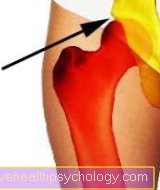
Diseases in the pelvic area associated with groin pain can, for example, be caused by pronounced Misaligned feet, Leg length differences, Posture errors or muscular imbalance be evoked. Above all, excessive stress on one half of the body represents a considerable risk factor for the development of hip joint diseases that lead to left or right groin pain. At the beginning, the resulting disorders are usually purely functional and reversible (reversible). However, in the long run, they can lead to permanent problems. For this reason, incorrect posture, incorrect loads and muscle imbalances should be treated as early as possible.
The most common diseases that play a role in this context are Hip arthrosis and the Impingement of the hip. Both diseases can develop on the right, left or both sides. The so-called "Impingement Syndrome“Structures bump into or become trapped.
Especially changes in shape in the area of the bony Hip joint (for example of the femoral head or the acetabulum) can cause such impingement. The cause in this case is a change in shape of the transition between the femoral head and Femoral neck or a hip socket that encircles the femoral head too much. As a result, the thighbone's neck hits the anterior acetabular roof when the thigh is bent or adducted (bringing it closer to the body) and in this way causes the typical pain symptoms. In addition, there can be combinations of the two changes in shape.
Symptoms
Diseases of the muscles, tendons or bony parts of the hip joint usually lead to groin pain that can radiate into the abdomen and / or thigh. If the disease is based on a pronounced difference in leg length, this can also affect the spine.
In the worst case, this can lead to a herniated disc in the lumbar spine. Hip impingement, on the other hand, causes groin pain on the left, right or both sides of the affected patient, which initially only occurs after prolonged exercise. In particular, cycling, climbing stairs and simply flexing the hip joint are increasingly perceived as painful.
Also read something on the topic: Burning in the groin.
therapy
The muscular diseases that are typical for the development of groin pain are usually treated in a targeted manner physiotherapy training. This can cause the muscle imbalance to be corrected and the groin pain to go away. Diseases of the bony Hip joint however, usually require more extensive treatment.
4) abscesses and vascular diseases
Abscesses right, left or both sides are among the rare diseases that lead to groin pain. Especially the so-called "Subsidence abscess in the pool "(Psoas abscess) plays a crucial role in this context. An abscess usually arises through purulent Melts within an inflamed tissue section. In the pelvis, abscesses typically spread along the lumbar iliac muscle (Psoas muscle) down to the bar. In addition, bulges (Aneurysms) of the femoral artery cause groin pain on the right or left. In the case of an aneurysm, either the entire wall of the vessel bulges outward or just some of the wall layers. The vessel wall becomes thinner at this point and can tear.
causes
Often the subsidence goesabscess from one bacterial Infection of the Lumbar spine, a purulent Hip prosthesis or that Intestines out. A subsidence abscess can appear on the right or left, as well as bilateral. The main cause of the development of a femoral artery aneurysm is the Vascular calcification (arteriosclerosis).
Symptoms
Patients who have a Subsidence abscess exhibit, often notice local Protrusions in the area of the groin. In addition, the abscess typically severely restricts hip mobility. In the early stages, in particular, there is usually no groin pain, as the increase in pressure within the tissue is still relatively small. However, as the stage progresses, this pressure increases and causes severe groin pain in the affected patient.
In addition, groin pain is one of the typical symptoms of one Thigh aneurysms. Patients who attend a Aneurysm of the femoral artery suffer, often notice one pulsating lumpthat can grow in size. A direct consequence of the progressive vascular sac can be a Circulatory disorder the lower extremity. Depending on the location of the aneurysm, either left or right (very rarely bilateral) Signs of Lack of oxygen on. The most important signs in this context include white / bluish Skin discoloration, pain and Paresthesia.
Complications
The most serious complication of such a thing Descending abscesses is the spontaneous opening towards the Body interior. If the abscess cavity bursts in an uncontrolled manner, the causal one can be transgressed bacteria in the blood circulation come. In this case there is a risk of developing a life-threatening one Blood poisoning (sepsis).
therapy
A Vascular sac the femoral artery usually becomes operational treated. The supply of the affected artery with a so-called Venous bypass (bypass circuit, see also "Bypass surgery"at Coronary artery disease therapy) is now part of standard therapy Aneurysms.
Of the Subsidence abscess is typically opened and removed surgically. In addition, the affected patient needs to prevent possible complications antibiotic take in.
You can read more about this topic here: Abscess in the groin
Groin pain during pregnancy

The most common cause of groin pain during pregnancy is the so-called "Pelvic ring loosening". The "pelvic ring loosening" is a Stretching of the ligamentsthat hold the individual pelvic bones together. This stretching can occur both in the early stages of pregnancy and only triggered by the birth process. However, the pelvic ring loosening is essential for the actual birth process essential.
Typical symptoms of this process are groin pain and discomfort in the area Lumbar, of the Spine and des Pubic bone. Due to the enormous stretching of the ligaments, walking and overall mobility can be severely restricted. A wrong posture During pregnancy, the symptoms typical of pelvic ring loosening can favor. Although groin pain is not uncommon during pregnancy, the symptoms should not be accepted as such. Physical relief can help relieve groin pain and increase the expectant mother's wellbeing.
Groin pain in children
Groin pain in children can have various causes. In general, one always has to choose between these causes innate and acquired Differentiate diseases. Inguinal hernias (Synonym: Inguinal hernia) are among the most common reasons for groin pain to develop in children. The term inguinal hernia means the penetration of Peritoneum and Intestinal sections through the abdominal wall. Typically, the point of passage of the hernial sac represents a natural weak point in the abdominal wall. Strong pressure during bowel movements can significantly increase the risk of developing an inguinal hernia in children. Parents of affected children usually notice a small bump in the groin area that quickly increases in size. Groin pain and a pronounced Tenderness in the area of this bump are typical symptoms of an inguinal hernia. Complications can only be avoided through a prompt medical consultation and the immediate initiation of a suitable therapy.
In addition, congenital malpositions of the hip joint can lead to groin pain in children. It is particularly common for newborns to have anomalies in the area of the acetabulum that encourage the femoral head to slide outdislocation, see also Hip dysplasia). This can be especially painful for children.
You should also be particularly urgent if children experience groin pain that extends to the testicles. In these cases, the actual cause of the groin pain usually lies within the scrotum. Possible diseases that lead to groin and testicular pain are those Testicular torsion and the Hydrocele (Accumulation of liquid). With testicular torsion, the testicle is twisted around the vascular style within the scrotum. As a result, the testicular tissue is no longer supplied with blood. This disease is one serious emergency. If the testicular torsion is not corrected by surgery within a few hours, the affected testicle will die.
Groin pain after exercise
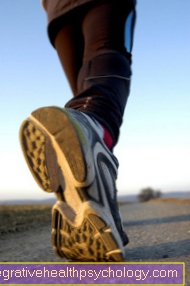
Groin pain can be especially frequent after Sports to be watched. For example, people who experience groin pain after jogging should consider temporarily stopping any physical activity. Reason for groin pain after exercise can be one Overload of the muscles or missing Warm up before exercise. For groin pain that occurs immediately after exercise (especially after to jog) occur, there is often one with those affected Groin strain in front. Usually there are different muscles and tendon attachments in the area of the thigh and the Basin affected, the activation of which requires use (Adduction) of the legs.
The discomfort caused by the strain is in most cases quite easy to recognize. Typically, those affected feel it during or immediately after exercise cramps and groin pain that even extends to the Inside of the thighs can radiate. In addition, those affected usually notice a pronounced feeling of tightness in the groin region. As a rule, groin pain always increases in the presence of a groin strain when rotating the legs. In severe cases apply Swelling, Bruising (Hematomas) and limited mobility in addition to pain as classic symptoms. In addition, stabbing and sharp groin pain occurs even during normal walking. However, if there is only a slight strain, the pain symptoms are often only observed under stress.


